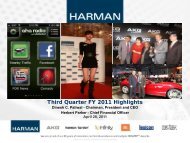You also want an ePaper? Increase the reach of your titles
YUMPU automatically turns print PDFs into web optimized ePapers that Google loves.
Excess Tax Benefits<br />
<strong>Harman</strong> International Industries, Incorporated and Subsidiaries<br />
(Dollars in thousands, except per-share data and unless otherwise indicated)<br />
We include the cash flows related to tax benefits resulting from tax deductions in excess of the<br />
compensation cost recognized (excess tax benefits) as financing cash flows in our Consolidated Statements of<br />
Cash Flows, in accordance with accounting principles generally accepted in the United States. Excess tax<br />
benefits for the years ended June 30, 2009, 2008 and 2007, were $0.1 million, $5.3 million and $<strong>10</strong>.5 million,<br />
respectively.<br />
Fair Value Determination<br />
The fair value of each option award is estimated on the date of grant using the Black-Scholes option<br />
valuation model, which uses the assumptions noted in the following table.<br />
2009<br />
Year Ended June 30,<br />
2008 2007<br />
Expected volatility .................................... 42.0 – 72.6% 35.1% – 52.0% 34.2% – 42.0%<br />
Weighted-average volatility ............................. 50.2% 40.7% 36.2%<br />
Expected annual dividend ............................... — $0.05 $0.05<br />
Expected term (in years) ................................ 1.89 – 6.51 1.69 – 6.71 1.42 – 7.69<br />
Risk-free rate ......................................... 0.81% – 3.64% 1.80% – 5.01% 4.43% – 4.97%<br />
Groups of option holders (directors, executives and non-executives) that have similar historical behavior are<br />
considered separately for valuation purposes. Expected volatilities are based on historical closing prices of our<br />
common stock over the expected option term. We use historical data to estimate option exercises and employee<br />
terminations within the valuation model. The expected term of options granted is derived using the option<br />
valuation model and represents the estimated period of time from the date of grant that the option is expected to<br />
remain outstanding. The risk-free rate for periods within the contractual life of the option is based on the U.S.<br />
Treasury yield curve in effect at the time of grant.<br />
Stock Option Activity<br />
A summary of option activity under our stock option plans for the year ended June 30, 2009 and changes<br />
during the year are presented below:<br />
Shares<br />
Weighted<br />
Average<br />
Exercise<br />
Price<br />
Weighted<br />
Average<br />
Remaining<br />
Contractual<br />
Term (Years)<br />
Aggregate<br />
Intrinsic<br />
Value<br />
Outstanding at July 1, 2008 ............................. 2,636,627 $62.22 6.40 $7,018<br />
Granted ......................................... 809,735 30.69<br />
Exercised ....................................... (50,720) 11.23<br />
Forfeited or expired ............................... (766,260) 74.87<br />
Outstanding at June 30, 2009 ............................ 2,629,382 61.02 7.51 $ 679<br />
Exercisable at June 30, 2009 ............................ 853,340 $69.14 5.51 $ 490<br />
The weighted-average grant-date fair value of options granted during the years ended June 30, 2009, 2008<br />
and 2007 was $11.18, $21.44 and $31.61, respectively. The total intrinsic value of options exercised during the<br />
years ended June 30, 2009, 2008 and 2007 was $0.4 million, $27.8 million and $42.9 million, respectively.<br />
78





